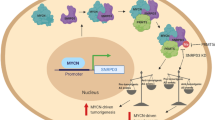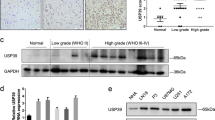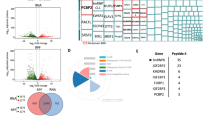Abstract
When oxygen is abundant, quiescent cells efficiently extract energy from glucose primarily by oxidative phosphorylation, whereas under the same conditions tumour cells consume glucose more avidly, converting it to lactate. This long-observed phenomenon is known as aerobic glycolysis1, and is important for cell growth2,3. Because aerobic glycolysis is only useful to growing cells, it is tightly regulated in a proliferation-linked manner4. In mammals, this is partly achieved through control of pyruvate kinase isoform expression. The embryonic pyruvate kinase isoform, PKM2, is almost universally re-expressed in cancer2, and promotes aerobic glycolysis, whereas the adult isoform, PKM1, promotes oxidative phosphorylation2. These two isoforms result from mutually exclusive alternative splicing of the PKM pre-mRNA, reflecting inclusion of either exon 9 (PKM1) or exon 10 (PKM2). Here we show that three heterogeneous nuclear ribonucleoprotein (hnRNP) proteins, polypyrimidine tract binding protein (PTB, also known as hnRNPI), hnRNPA1 and hnRNPA2, bind repressively to sequences flanking exon 9, resulting in exon 10 inclusion. We also demonstrate that the oncogenic transcription factor c-Myc upregulates transcription of PTB, hnRNPA1 and hnRNPA2, ensuring a high PKM2/PKM1 ratio. Establishing a relevance to cancer, we show that human gliomas overexpress c-Myc, PTB, hnRNPA1 and hnRNPA2 in a manner that correlates with PKM2 expression. Our results thus define a pathway that regulates an alternative splicing event required for tumour cell proliferation.
This is a preview of subscription content, access via your institution
Access options
Subscribe to this journal
Receive 51 print issues and online access
$199.00 per year
only $3.90 per issue
Buy this article
- Purchase on Springer Link
- Instant access to full article PDF
Prices may be subject to local taxes which are calculated during checkout




Similar content being viewed by others
References
Warburg, O. On the origin of cancer cells. Science 123, 309–314 (1956)
Christofk, H. R. et al. The M2 splice isoform of pyruvate kinase is important for cancer metabolism and tumour growth. Nature 452, 230–233 (2008)
Vander Heiden, M. G., Cantley, L. C. & Thompson, C. B. Understanding the Warburg effect: the metabolic requirements of cell proliferation. Science 324, 1029–1033 (2009)
Wang, T., Marquardt, C. & Foker, J. Aerobic glycolysis during lymphocyte proliferation. Nature 261, 702–705 (1976)
Christofk, H. R., Vander Heiden, M. G., Wu, N., Asara, J. M. & Cantley, L. C. Pyruvate kinase M2 is a phosphotyrosine-binding protein. Nature 452, 181–186 (2008)
Takenaka, M. et al. Alternative splicing of the pyruvate kinase M gene in a minigene system. Eur. J. Biochem. 235, 366–371 (1996)
Kashima, T., Rao, N., David, C. J. & Manley, J. L. hnRNP A1 functions with specificity in repression of SMN2 exon 7 splicing. Hum. Mol. Genet. 16, 3149–3159 (2007)
Del Gatto-Konczak, F., Olive, M., Gesnel, M. C. & Breathnach, R. hnRNP A1 recruited to an exon in vivo can function as an exon splicing silencer. Mol. Cell. Biol. 19, 251–260 (1999)
Burd, C. G. & Dreyfuss, G. RNA binding specificity of hnRNP A1: significance of hnRNP A1 high-affinity binding sites in pre-mRNA splicing. EMBO J. 13, 1197–1204 (1994)
Spellman, R. & Smith, C. W. Novel modes of splicing repression by PTB. Trends Biochem. Sci. 31, 73–76 (2006)
Sauliere, J., Sureau, A., Expert-Bezancon, A. & Marie, J. The polypyrimidine tract binding protein (PTB) represses splicing of exon 6B from the β-tropomyosin pre-mRNA by directly interfering with the binding of the U2AF65 subunit. Mol. Cell. Biol. 26, 8755–8769 (2006)
Pomeranz Krummel, D. A., Oubridge, C., Leung, A. K., Li, J. & Nagai, K. Crystal structure of human spliceosomal U1 snRNP at 5.5 Å resolution. Nature 458, 475–480 (2009)
Spellman, R., Llorian, M. & Smith, C. W. Crossregulation and functional redundancy between the splicing regulator PTB and its paralogs nPTB and ROD1. Mol. Cell 27, 420–434 (2007)
Harada, Y., Nakamura, M. & Asano, A. Temporally distinctive changes of alternative splicing patterns during myogenic differentiation of C2C12 cells. J. Biochem. 118, 780–790 (1995)
Boutz, P. L., Chawla, G., Stoilov, P. & Black, D. L. MicroRNAs regulate the expression of the alternative splicing factor nPTB during muscle development. Genes Dev. 21, 71–84 (2007)
Zheng, H. et al. p53 and Pten control neural and glioma stem/progenitor cell renewal and differentiation. Nature 455, 1129–1133 (2008)
Birney, E. et al. Identification and analysis of functional elements in 1% of the human genome by the ENCODE pilot project. Nature 447, 799–816 (2007)
Chen, X. et al. Integration of external signaling pathways with the core transcriptional network in embryonic stem cells. Cell 133, 1106–1117 (2008)
Shiio, Y. et al. Quantitative proteomic analysis of Myc oncoprotein function. EMBO J. 21, 5088–5096 (2002)
Schlosser, I. et al. Dissection of transcriptional programmes in response to serum and c-Myc in a human B-cell line. Oncogene 24, 520–524 (2005)
Eilers, M. & Eisenman, R. N. Myc’s broad reach. Genes Dev. 22, 2755–2766 (2008)
Wu, K. J., Mattioli, M., Morse, H. C. & Dalla-Favera, R. c-MYC activates protein kinase A (PKA) by direct transcriptional activation of the PKA catalytic subunit beta (PKA-Cβ) gene. Oncogene 21, 7872–7882 (2002)
Giacinti, C. & Giordano, A. RB and cell cycle progression. Oncogene 25, 5220–5227 (2006)
Martinez-Contreras, R. et al. Intronic binding sites for hnRNP A/B and hnRNP F/H proteins stimulate pre-mRNA splicing. PLoS Biol. 4, e21 (2006)
Biamonti, G. et al. Human hnRNP protein A1 gene expression. Structural and functional characterization of the promoter. J. Mol. Biol. 230, 77–89 (1993)
Zerbe, L. K. et al. Relative amounts of antagonistic splicing factors, hnRNP A1 and ASF/SF2, change during neoplastic lung growth: implications for pre-mRNA processing. Mol. Carcinog. 41, 187–196 (2004)
He, X. et al. Knockdown of polypyrimidine tract-binding protein suppresses ovarian tumor cell growth and invasiveness in vitro . Oncogene 26, 4961–4968 (2007)
Hanamura, A., Caceres, J. F., Mayeda, A., Franza, B. R. & Krainer, A. R. Regulated tissue-specific expression of antagonistic pre-mRNA splicing factors. RNA 4, 430–444 (1998)
Zhou, J. et al. Differential expression of the early lung cancer detection marker, heterogeneous nuclear ribonucleoprotein-A2/B1 (hnRNP-A2/B1) in normal breast and neoplastic breast cancer. Breast Cancer Res. Treat. 66, 217–224 (2001)
Jin, W., McCutcheon, I. E., Fuller, G. N., Huang, E. S. & Cote, G. J. Fibroblast growth factor receptor-1 α-exon exclusion and polypyrimidine tract-binding protein in glioblastoma multiforme tumors. Cancer Res. 60, 1221–1224 (2000)
Krainer, A. R., Maniatis, T., Ruskin, B. & Green, M. R. Normal and mutant human β-globin pre-mRNAs are faithfully and efficiently spliced in vitro . Cell 36, 993–1005 (1984)
Acknowledgements
We thank D. Black for BB7 antibody; T. Kashima for hnRNP A1/A2 siRNA; R. Prywes and E. Henckles for C2C12 cells; M. Sheetz and X. Zhang for NIH-3T3 cells; C. Prives, T. Barsotti and L. Biderman for MCF-7 cells, Rb and E2F1 siRNA; R. Dalla-Favera and Q. Shen for anti-c-Myc antibodies and c-Myc expression vector; R. Eisenman for N-Myc antibody; and members of the Manley laboratory for discussions. This work was supported by grants from the Avon Foundation and the NIH.
Author Contributions C.J.D., M.C. and J.L.M. conceived the project and designed experiments, C.J.D. and M.C. carried out experiments, P.C. and M.A. provided tumour samples, and C.J.D., M.C. and J.L.M. interpreted data and wrote the paper.
Author information
Authors and Affiliations
Corresponding author
Ethics declarations
Competing interests
The authors declare no competing financial interests.
Supplementary information
Supplementary Figures
This file contains Supplementary Figures 1-14 with Legends. (PDF 705 kb)
Rights and permissions
About this article
Cite this article
David, C., Chen, M., Assanah, M. et al. HnRNP proteins controlled by c-Myc deregulate pyruvate kinase mRNA splicing in cancer. Nature 463, 364–368 (2010). https://doi.org/10.1038/nature08697
Received:
Accepted:
Published:
Issue Date:
DOI: https://doi.org/10.1038/nature08697
This article is cited by
MAGOH promotes gastric cancer progression via hnRNPA1 expression inhibition-mediated RONΔ160/PI3K/AKT signaling pathway activation
Journal of Experimental & Clinical Cancer Research (2024)
USP43 stabilizes c-Myc to promote glycolysis and metastasis in bladder cancer
Cell Death & Disease (2024)
MYCN and SNRPD3 cooperate to maintain a balance of alternative splicing events that drives neuroblastoma progression
Oncogene (2024)
Inhibition of Pyruvate kinase M2 (PKM2) by shikonin attenuates isoproterenol-induced acute myocardial infarction via reduction in inflammation, hypoxia, apoptosis, and fibrosis
Naunyn-Schmiedeberg's Archives of Pharmacology (2024)
Epigenetic modification of m6A regulator proteins in cancer
Molecular Cancer (2023)
Comments
By submitting a comment you agree to abide by our Terms and Community Guidelines. If you find something abusive or that does not comply with our terms or guidelines please flag it as inappropriate.



